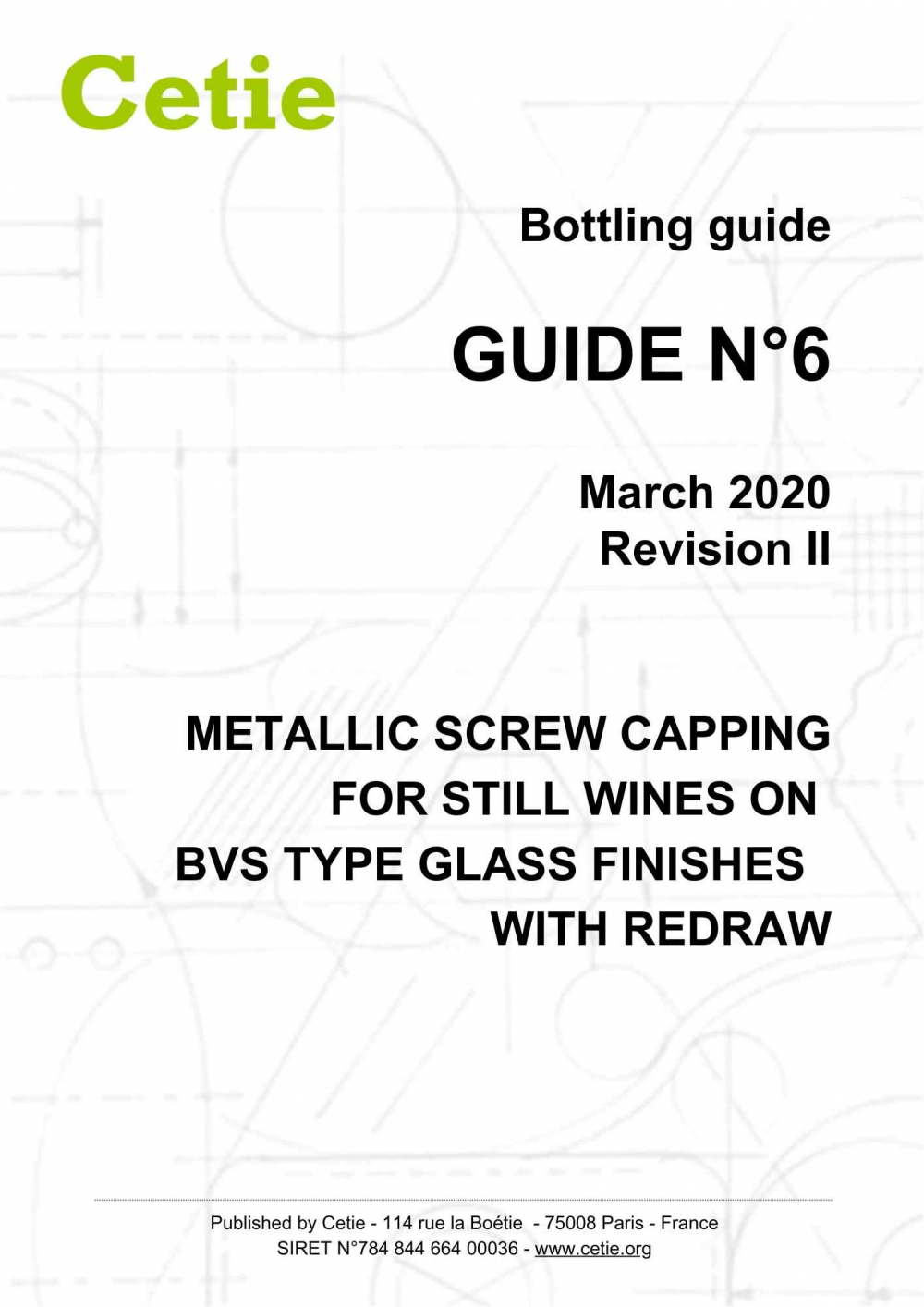Guide No. 6
Revision II
Published on: 11/03/2020
Metallic screw capping for still wines on BVS type glass finishes - With redraw
Scope of application
This Guide gives information on good practices for bottling still wine with aluminium screw caps on a BVS-type glass finish according to EN 16293 - PACKAGING - GLASS PACKAGING - DEEP BVS FINISHES FOR STILL WINES, with a redraw while the cap application..
For this Guide, wine is considered to be "still" with a CO2 content < 1,2 g CO2/l (as defined in EN 16293).
The Guide defines:
For this Guide, wine is considered to be "still" with a CO2 content < 1,2 g CO2/l (as defined in EN 16293).
The Guide defines:
- The functions of the closure and its limits,
- The specifications of each of the components are related to each other, to fulfil the global functions within determined limits.
Table of contents
1. Introduction
1.1 Scope
1.2 Units
1.3 Checking calibration of measuring equipment
2. Closure system for still wines
2.1 Presentation
2.2 Functions of the closure system
2.3 Headspace requirements
2.4 Internal pressure
3. Glass bottle finishes
1.1 Scope
1.2 Units
1.3 Checking calibration of measuring equipment
2. Closure system for still wines
2.1 Presentation
2.2 Functions of the closure system
2.3 Headspace requirements
2.4 Internal pressure
3. Glass bottle finishes
3.1 Presentation
3.2 Functions
3.3 Additional requirements
4. Caps
4.1 General presentation
4.2 Aluminium cap shells
4.2.1 Functions
4.2.2 Description
4.2.3 Additional specifications
4.3 Liners
4.3.1 Functions
4.3.2 Description
4.3.3 Examples of currently used liners
4.3.4 Choice of the liner
4.3.5 Oxygen transmission rate of liner materials
5. Inspection of components
5.1 Glass bottles
5.2 Caps
5.2.1 Pre consumption manual inspection
6. Equipment and application conditions
6.1 Introduction
6.2 Storage and application conditions
6.3 Cap application
6.4 Equipment
6.4.1 Initial checks
6.4.2 Initial checks of cap pick-up device
6.4.3 Operating cycle of the capping head
6.4.4 Initial check of capping head
6.4.5 Setting equipment
6.4.6 Machine specifications
7. Checking of capping during production
7.1 Recommended frequency
7.2 Checking the top load force
7.3 Visual checking of closures
7.3.1 Short skirt closure
7.3.2 Long skirt closure
7.3.3 Checking of liner compressibility
7.3.4 Checking of removal torque and strip torque
7.3.5 Verification of the pressure resistance of the closure
7.4 In-line optical inspection
8. Storage and transport of bottled products
8.1 Storage
8.2 Transport
8.3 Handling
9 Information to be recorded
9.1 Filling
9.2 Inerting
9.3 Capping
9.4 Verifications
10. Capping defects
11. Bibliography - Permeability of liner materials and sensitivity of wine to oxygen
12. End of life
13. Related documents
13.1 Standards
13.2 Cetie
14. Document history
15. Annexe A — Contributors to the first edition of 2016
16. Illustration index
17. Figures
18. Tables
3.2 Functions
3.3 Additional requirements
4. Caps
4.1 General presentation
4.2 Aluminium cap shells
4.2.1 Functions
4.2.2 Description
4.2.3 Additional specifications
4.3 Liners
4.3.1 Functions
4.3.2 Description
4.3.3 Examples of currently used liners
4.3.4 Choice of the liner
4.3.5 Oxygen transmission rate of liner materials
5. Inspection of components
5.1 Glass bottles
5.2 Caps
5.2.1 Pre consumption manual inspection
6. Equipment and application conditions
6.1 Introduction
6.2 Storage and application conditions
6.3 Cap application
6.4 Equipment
6.4.1 Initial checks
6.4.2 Initial checks of cap pick-up device
6.4.3 Operating cycle of the capping head
6.4.4 Initial check of capping head
6.4.5 Setting equipment
6.4.6 Machine specifications
7. Checking of capping during production
7.1 Recommended frequency
7.2 Checking the top load force
7.3 Visual checking of closures
7.3.1 Short skirt closure
7.3.2 Long skirt closure
7.3.3 Checking of liner compressibility
7.3.4 Checking of removal torque and strip torque
7.3.5 Verification of the pressure resistance of the closure
7.4 In-line optical inspection
8. Storage and transport of bottled products
8.1 Storage
8.2 Transport
8.3 Handling
9 Information to be recorded
9.1 Filling
9.2 Inerting
9.3 Capping
9.4 Verifications
10. Capping defects
11. Bibliography - Permeability of liner materials and sensitivity of wine to oxygen
12. End of life
13. Related documents
13.1 Standards
13.2 Cetie
14. Document history
15. Annexe A — Contributors to the first edition of 2016
16. Illustration index
17. Figures
18. Tables
History
First edition: 2007
Revision I: 01/2016
Revision II: 03/2020
First edition: 2007
Revision I: 01/2016
Revision II: 03/2020
Contributors
ACTEGA DS GMBH, AMCOR FLEXIBLES CAPSULES, ARDAGH GERMANY, ARDAGH UK, ARDAGH UK, BV GLAS, CAPSULES TORRENTE, CLOSURE LOGIC, DAIM POLSKA, ENCIRC GLASS, VERALLIA FRANCE, GRACE (HENKEL ADHESIVE TECHNOLOGIES), GUALA, BACARDI, HERTI FRANCE, JGPC, MGJ, NESTLÉ WATERS, SAVERGLASS, SAZERAC, VERALLIA FRANCE, VETROPACK, VINVENTIONS DEUTSCHLAND, WILLIAM GRANT & SONS, ZALKIN
Document under responsibility of working group:
Cap manufacturers wg1 and glass manufacturers wg3
WG chair: Klaus DEMBSKI - BUNDESVERBAND GLASINDUSTRIE E.V. (Federal Association of the German Glass Industry)
Vice WG chair : Mr. Giuseppe MENCACCI (Process innovation manager - GUALA CLOSURES S.P.A.)
This joint group aims to coordinate the production of documentation at the junction of glass container production and closure application. It accompanies the development of documentation for glass containers for different types of closures including, but not limited to, aluminum screw caps, crown caps, and their components (liners). This joint group also provides an opportunity for cap and liners manufacturers to open discussions on specific work items of the permanent glass groups
This joint group aims to coordinate the production of documentation at the junction of glass container production and closure application. It accompanies the development of documentation for glass containers for different types of closures including, but not limited to, aluminum screw caps, crown caps, and their components (liners). This joint group also provides an opportunity for cap and liners manufacturers to open discussions on specific work items of the permanent glass groups
